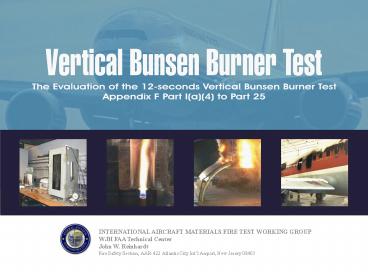INTERNATIONAL AIRCRAFT MATERIALS FIRE TEST WORKING GROUP - PowerPoint PPT Presentation
Title:
INTERNATIONAL AIRCRAFT MATERIALS FIRE TEST WORKING GROUP
Description:
INTERNATIONAL AIRCRAFT MATERIALS FIRE TEST WORKING GROUP – PowerPoint PPT presentation
Number of Views:543
Avg rating:3.0/5.0
Title: INTERNATIONAL AIRCRAFT MATERIALS FIRE TEST WORKING GROUP
1
INTERNATIONAL AIRCRAFT MATERIALS FIRE TEST
WORKING GROUP WJH FAA Technical Center John W.
Reinhardt Fire Safety Section, AAR-422 Atlantic
City Intl Airport, New Jersey 08405
2
- Objective
- Introduction
- Technical Approach for Evaluation Program
- Test Results
- Conclusion
- Recommendations
- On-going Work
- Acknowledgement
3
To determine if the current FAA compliance test
(12-sec Vertical Bunsen Burner Test), which is
used to certify air conditioning ducts and
electrical conduits, is comprehensive enough to
differentiate between a fire worthy and non-fire
worthy material as expected in todays aviation
industry.
4
- Because of improvement in material technology
and the interest of minimizing hidden fire
threats in commercial aircraft, the FAA
re-examined one of its required certification
tests. - The re-examined test was the 12-seconds vertical
Bunsen burner test (found in the Code of Federal
Regulations Title 14 Chapter I Part 25 Appendix F
Part I (a)(4)) which is use to certify components
like ducts and conduits.
Fire in Cheek Area AirTran DC-9-32, Atlanta,
11/29/00
Fire in Bulkhead AirTran DC-9-32, Greensboro,
8/8/00
5
- The approach selected to determine the
effectiveness of the 12-sec Vertical Bunsen
Burner test was by conducting a testing program. - 12 sec Vertical Bunsen Burner Test (Baseline)
- Intermediate-Scale Test
- Heat Release Test
- Smoke Test
- Micro-Scale Calorimeter Test
- Radiant Panel Test
6
12-Seconds Vertical Bunsen Burner Test
Test Protocol Chapter 1 of DOT/FAA/CT-89/15
Aircraft Material Fire Test Handbook Sample Size
75mm x 305mm Heat Source Methane Flame (41
kW/m2, 925 ºC) Heat Source Exposure 12
seconds Flame Extinguishing Time lt15
seconds Burn Length lt20.32cm Drip Extinguishing
Time lt5 seconds
7
Intermediate-Scale Fire Test
Test Protocol FAA Report DOT/FAA/AR-99/44 - Dev.
Of Improved Flammability Criteria for Aircraft
Thermal Acoustic Insulation Sample Size 15.2cm
(30.4cm) x 243.8cm Heat Source Polyurethane Foam
Block (49 kW/m2, 781 ºC) Heat Source Exposure
10 minutes Not a compliance test
8
(No Transcript)
9
Heat Release Rate Test for Cabin Materials
Test Protocol Chapter 5 of DOT/FAA/CT-89/15
Aircraft Material Fire Test Handbook Sample Size
150mm x 150mm Heat Source Methane Flame
Radiant Heating Coils (35 kW/m2) Heat Source
Exposure 5 minutes Max Avg. Heat Release Rate
lt65 kW/m2 Max Avg. Total Heat Released (2 min)
lt65 kWmin/ m2
10
Smoke Test for Cabin Materials
Test Protocol Chapter 6 of DOT/FAA/CT-89/15
Aircraft Material Fire Test Handbook Sample Size
73mm x 73mm Heat Source Methane Flame Radiant
Heating Coils (25 kW/m2) Heat Source Exposure 4
minutes Max Avg. Specific Optical Density, Dm
lt200
11
Micro-scale Combustion Calorimeter Test
Test Protocol FAA Report DOT/FAA/AR-01/117 A
Microscale Combustion Calorimeter Sample Size 1
milligram Heat Source Heating Coils (900
ºC) Heat Source Exposure 10 to 120 seconds to
effect pyrolysis Not a compliance test
12
Radiant Panel Test
Test Protocol Appendix F to Part 25 (Part IV)
Test Method To Determine the Flammability and
Flame Propagation Characteristics of
Thermal/Acoustic Insulation Materials Sample
Size 318mm x 584mm Heat Source Propane Flame
Radiant Heating Coils (17 kW/m2 panel, 147 kW/m2
pilot) Heat Source Exposure 15 seconds (pilot)
and until flames are extinguished (radiant
panel) Max Flame Propagation lt 5.08 cm Max Flame
Time lt 3 seconds
13
12 Seconds Vertical Bunsen Burner Test
14
12 Seconds Vertical Bunsen Burner Test
15
Intermediate-Scale Fire Test (Pretest)
16
Intermediate-Scale Fire Test
17
Intermediate-Scale Fire Test
18
Heat Release Rate Test for Cabin Materials
19
Microscale Calorimeter Test
20
Smoke Test for Cabin Materials
21
Radiant Panel Test
22
Radiant Panel Test
23
- The evaluation test results showed that the
currently used method to certify aircraft ducts
and conduits, that is the 12-second Vertical
Bunsen Burner test, is not robust enough to
correctly differentiate between a fireworthy and
a non-fireworthy material as expected by todays
level of safety. - The intermediate-scale test, the OSU heat
release rate test, and the radiant panel test
showed how deficient is the fireworthiness
property of the evaluated aircraft material
(fiberglass/epoxy/polyurethane composite).
24
The William J. Hughes FAA Technical Center
recommends that a new fire test method be
developed and used to certify the materials that
fall under that particular federal regulation.
25
Additional aircraft duct materials are currently
been tested to characterize their fireworthiness
and provide data for the development of a new
test for means of compliance with FAR 25.853
(Compartment Interiors).
26
Material Available for Testing
27
Many thanks to the following people for their
assistance in this program
Eldon Barr, Triumph Composite Systems Pat Cahill,
FAA Joseph Canavan, Triumph Composite
Systems Brian Conover, GSC Sean Crowley, GSC FAA
Video Crew Frank Gibbons, GSC Susan Glicksberg,
Boeing Richard Johnson, FAA Kendall Krieg, Boeing
Doug Maben, Boeing Barbara Maclean, Boeing Tim
Marker, FAA Rich Mazzone, Boeing Jim Peterson,
Boeing Paul Scrofani, GSC Dan Slaton, Boeing Rich
Walters, GSC Rick Whedbee, GSC































